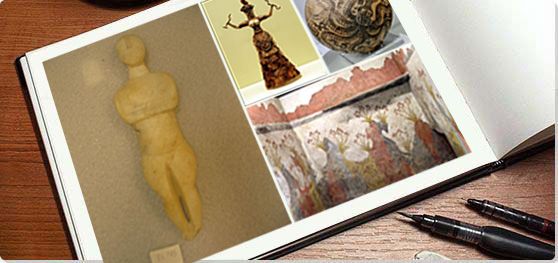Summary of Aegean Art: Cycladic, Minoan, and Mycenaean
The rocky and sun-soaked islands of the Aegean Sea once housed civilizations that produced a wealth of unique, influential, and mysterious artworks and cultural artefacts. Spreading across these islands and even into the southern part of the mainland Greek peninsula before disappearing without a clear explanation, these cultures are remembered by the objects and ruins that have survived and been reclaimed through architectural excavation. Perhaps the best example of these cultures' ongoing appeal and mystery can be seen at the preserved ruins that make up the popular tourist site of Mycenae.
The extensive cache of art and architectural ruins left behind has been generally divided into three main styles after the societies that successively dominated the region: Cycladic, Minoan, and Mycenaean. Together these cultures both prefigure and diverge from the styles and subjects of Classical Greek Art and have proven to be massively influential on the later development of Western artistic practice, from the aesthetics of Roman Art to the Renaissance, Cubism, and Surrealism. 20th-Century European artists in particular turned to the flat and geometric abstractions of the human form seen in Cycladic art to create new styles and subvert expectations grounded in classical sensibilities and perspectives. These ancient Aegean cultures therefore represent a vital (if often unacknowledged) influence on the direction of artistic expression in Europe.
Key Ideas & Accomplishments
- Aegean Art is a lesser known but essential precursor to Classical Greek Art, establishing the parameters of visual metaphor that would be developed through the classical period in Greece and Rome. It is only through protracted archeological work that the importance of Aegean Art has become apparent, steadily revealed through the discovery of each new find.
- Cycladic sculpture has a high degree of abstraction, particularly in its statuary, which proved to be deeply influential to 20th-Century European artists interested in "primitive" or "pre-historical" art that did not bear the weight of centuries of aesthetic tradition. There is a convincing argument to be made that Aegean Art directly inspired the abstract practice of several hugely important post-war artists, including both Pablo Picasso and Alberto Giacometti.
- The Aegean culture of the Minoans developed "buon fresco" or true fresco, where pigments are set into wet plaster rather than painted onto a dry wall. This represents a huge advancement that facilitated the preservation of subsequent wall paintings in later cultures as well as their own, most notably in the Greek and Roman frescoes that are still vibrant today.
- Architecturally, Aegean cultures demonstrated a high level of ambition and innovation. The Mycenaeans created so called beehive tombs, with an interior oblong domed space accomplished through fitted layers of stone, showing an early attempt at the arch-based structural engineering perfected by the Romans over a thousand years later. The development of this architectural form is foundational to the history of European building and ornamentation.
Artworks and Artists of Aegean Art: Cycladic, Minoan, and Mycenaean
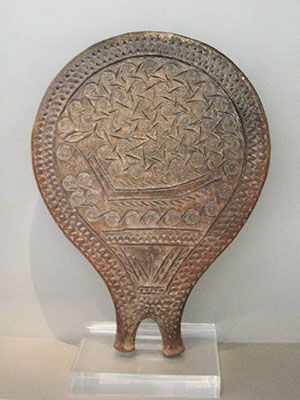
Cycladic frying pan
An example of a Cycladic pottery type known as a frying pan for its distinct shape, this piece is especially impressive for its detailed surface design. According to Katia Manteli, on the National Archaeological Museum of Athens's website, "on the underside of the base of this handmade clay frying pan from Syros a Cycladic craftsman incised a ship with 28 oars amid the 'frothy' waves as though it was viewed from above." This imagery may reflect a tradition of seafaring in the region that dates from much earlier through its schematic representation.
Whilst like many examples of Aegean art the exact purpose of this artwork is unknown, its presence in a Cycladic tomb implies a funerary function. As Manteli explains, "the vessel had been deposited as funerary offering in the cemetery of Chalandriani on Syros that comprised 600 tombs. [...] The image of the fish differed on each representation [of the several pans found in these tombs] giving the impression that its identity was associated with the symbolism which each kind of fish entailed as an emblem at the acrostolion (extreme part of the prow). The small number of burials furnished with frying-pan vessels may reflect the status of their dead possessors as "shipowners", a view that is further reinforced by the possible use of these vessels as navigational liquid mirrors. Simultaneously, they are associated with ritual enactments, judging from the occurrence of a pubic triangle above the forked handle, without any apparent thematic relevance to the main representation."
Clay - Collection of National Archaeological Museum, Athens
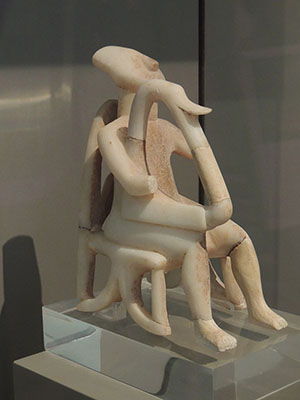
Marble statuette of a male figure playing a musical instrument, lyre or harp
This nine-inch sculpture is one of the most interesting surviving Aegean Cycladic figurines as one of few representations of males among over 1000 examples discovered through architectural excavation. Its overall sculptural form, including pose and harp-like instrument, is the most complex of those known, male or female. It is though apparently a recurring type, as there are at least seven extant examples of similar poses. Only one other seated pose is known - a unique male cup bearer. Other males are depicted in the simplified elongated style of the more abundant females with their spindly arms positioned on or close to the body. Often the main differentiation between male and female figures is only the lack of breast protuberances. To a lesser degree, genital demarcations between males and females are apparent, though unlike the females, most male figures have attributes such as belts, bandoliers, or musical instruments, some quite detailed, such as the duck-bill or swan-head ornament harp shown on this example.
As they were virtually all found in tombs, anthropomorphic Cycladic figurines are widely believed to have had funerary and/or burial functions, in common with much known ancient art globally. As Kleiner states, in terms of its intended purpose, "... this seated musician may be playing for the deceased in the afterlife," although other ritual functions may also have applied. While more tubular in anatomy, the head of this type retains the angular planarity of the most common female type.
Cycladic figures have had substantial impact on modern artists, not only in form but "truth to material ... one of the first principles of art so clearly seen in primitive work," as British sculptor Henry Moore wrote in 1941. However he and many other modernists were considering the smoothed marble surfaces of Cycladic objects without the original fugitive polychrome elements discovered through new scientific methods in the postwar era.
Marble - Collection of National Archaeological Museum, Athens, Greece
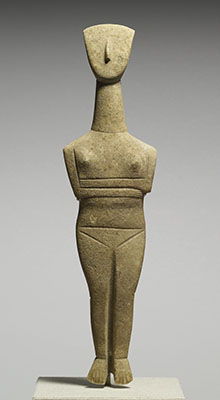
Cycladic Female Figurine
This sculpture is an apparently common type in Cycladic art generally designated "Folded Arm Figurines." According to author Philip Betancourt "...the group as a whole shares the main characteristics: a nude, frontal, female form with the head and body straight and the legs held together; toes pointed down so the figure cannot stand; arms held tightly across the body and folded one above the other below the breasts; and a minimum of details." According to the Walters Art Museum website, "this example represents the high point of Cycladic figurine carving, when the form had become extremely elegant."
Cycladic figures such as this one are considered one of the great mysteries of Aegean art due to their abundance. Without written records, we can never know their original meaning or the motivations for such copious production at a time when only very primitive tools were available for stone carving. Most scholars believe that they relate to fertility or "woman" broadly and are not portraits or individual likenesses in the modern sense. As the Walters Art Museum states, "Although it was first believed that these so-called 'idols' represent deities, they probably should be interpreted more broadly as representations of 'femaleness'." Many, but not all, have been found in burials and it has been suggested that they may have had multiple functions, accounting for their ubiquity.
Female Cycladic figures have had a substantial influence on modern artists. According to author Julia Fiore, "from a formal perspective, the link between Cycladic art and modern sculpture seems obvious: The abstract simplicity, highly stylized forms, and balanced proportions of the many white marble figurines and vessels unearthed from the Aegean islands clearly translate to well-known examples of today's most famous sculptures." Many sculptural and some painted works by acclaimed early 20th-century artists Modigliani, Brancusi, Modigliani, Arp, and Picasso, reflect inspiration if not direct stylistic borrowing from similar Cycladic female figurines.
Marble - Collection of Walters Art Museum, Baltimore, Maryland
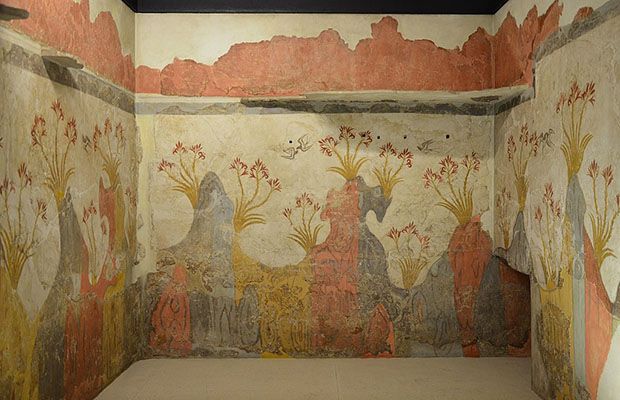
Spring Fresco (Reconstruction of the walls of room Delta 2, Akrotiri, Thera)
This Minoan fresco, painted on the walls of an excavated room on the Cyclades island of Thera, features a multi-colored rocky landscape from which lush plants and flowers bloom. Above the vegetation, a group of swallows are depicted in the sky. "Ironically, the subject of the Spring Fresco is not springtime," author Philip Betancourt explains, "so the name given by the excavator is wrong. The birds are poised with their beaks together, but they are not kissing in mid-air [...]. The scene happens in the autumn when dutiful adult swallows continue to feed their offspring even after the young birds are mature enough to fly, and the parents even feed them in mid-air, so the scene shows a parent feeding its almost grown youngster 'on the fly'."
This work shows the skill of the Aegean artists in buon or wet fresco, far more durable than dry wall painting employed by other civilizations up to that time. Interestingly, most scholars of Minoan art believe that painting technique, composition and style were reciprocally developed and intertwined. The limited earthen palette employed here and in Minoan frescos generally was largely determined by natural and predominantly local raw pigments available to artists. This has been demonstrated through modern scientific testing, which has also indicated the broadening of color range through concentration and dilution, and mineral processing.
According to author Fred Kleiner this mural, "...is the largest and most complete prehistoric example of pure landscape painting. ... [T]he irrationally undulating and vividly colored rocks, the graceful lilies swaying in the cool island breezes, and the darting swallows express the vigor of growth, the delicacy of flowering, and the lightness of birdsong and flight. In the lyrical language of curving lines the artist celebrated the rhythms of nature. The Spring Fresco represents the polar opposite of the first efforts at mural painting in the caves of Paleolithic Europe, where animals (and occasionally humans) appeared as isolated figures with no indication of setting." A work such as this suggests that specific aesthetic tastes and perhaps the notion of art for art's sake was important in the design of Aegean palaces.
Pigment - Collection of National Archaeological Museum, Athens, Greece
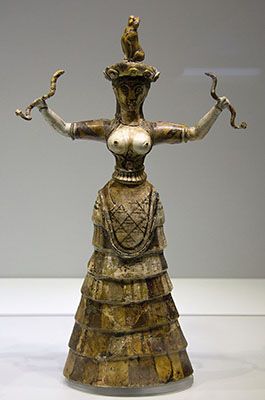
Snake Goddess
Measuring just over a foot tall, the Minoan Snake Goddess sculpture features an ornately dressed woman with her breasts exposed and arms outstretched in front of her. In each hand she holds a large, writhing snake, while an animal that has been largely interpreted as a cat sits perched on her crowned head. Its ceramic medium of faience required substantial knowledge of clay and glaze mixtures and kiln temperatures to achieve detailed polychrome results.
One of the most detailed sculptures from the Minoan period, this figure is the source of some debate as to whether it features a human woman, most likely a priestess, or an immortal goddess. The fact that several sculptures depicting females with similarly raised and outstretched arms and dress exist not only from Crete but also were produced later by the Mycenaeans on the Greek mainland, suggests a linked symbolic lineage. According to author Fred Kleiner, "the frontality of the figure is reminiscent of Egyptian and Mesopotamian statuary, but the costume, with its open bodice and flounced skirt, is distinctly Minoan. If the statuette represents a goddess, then the Minoan is yet another example of a culture fashioning its gods in the image of its people." Interestingly, this is just one of many examples of Minoan sculptures that have been found broken into several pieces and have since been reconstructed. While some have argued that this is simply the result of age and environmental damage, many believe that the sculptures were used in some sort of ritual which upon conclusion involved their deliberate breaking.
Faience - Collection of Archaeological Museum, Iraklion, Crete

Inlaid dagger blade with lion hunt
This nine-inch blade of a Mycenaean dagger was one of several found in a grave at Mycenae. We do not know if these decorative weapons were used in battle, were purely ceremonial, or were status objects.
The detail and array of metals and metallurgy techniques employed in creating this work may indicate a ceremonial purpose in lieu of or in addition to a status weapon used in war. Its design also highlights the impact of trade and the influence of other civilizations on the late Aegean Mycenaean people. As Kleiner explains, "the slim-waisted, long-haired figures are Minoan in style, but the artist borrowed the subject from the repertoire of Egypt and Mesopotamia (there were no lions in Greece at this date). It is likely that a Minoan metalworker made the dagger for a Mycenaean patron who admired Minoan art but whose tastes in subject matter differed from those of his Cretan counterparts." Specifically, according to author Philip Betancourt, "...the style of the scene with its figures in active poses and the lion with all four legs off the ground [...] is purely Cretan. The subject, on the other hand, is Mycenaean." The depiction is especially interesting for the adjusted poses of the hunters and lions to fit the diminishing blade ground, anticipating a similar strategy of maintaining relative figure scale in later Greek reliefs on temple pediments or triangular sections below the roof.
Little art with violent hunting or military-like imagery is known in Minoan art. Such a technically complicated work shows the affluence of the Mycenaeans able to commission works from other peoples, and also the awareness of the Aegeans more generally of important motifs of other civilizations through trade and travel. The notion of a man powerful enough to strike down the most ferocious of beasts (such as a lion) for instance, has a long history in the art of the Ancient Egyptians and of the Ancient Near East. The patron of this object possibly wanted himself depicted as the holder of the dagger defeating such a strong enemy, incarnating a visual metaphor for the Mycenaean's might and power over foreign enemies.
Bronze, inlaid with gold, silver, and niello - Collection of National Archaeological Museum, Athens, Greece
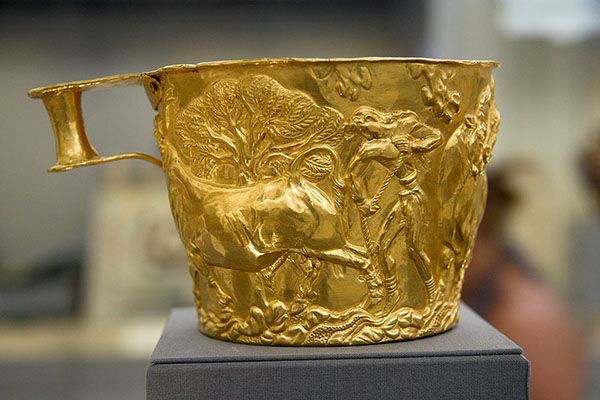
Hunter capturing a bull
This ornately detailed gold drinking cup is one of two similarly themed cups buried in the tholos tomb at Vapheio, a Mycenaean site in Greece. Featuring a narrative relief created through the repoussé process of hammering a design from the backside of a thin sheet of metal (in this case gold), the scene features a hunter capturing a bull. The muscles in his arms and legs are in full use as he tightens the rope he has tied around the bull's leg.
While the most famous Mycenaean golden artworks have come from the shaft graves at the citadel of Mycenae, this cup, according to author Fred Kleiner, "suggest[s] that gold objects were common in elite Mycenaean burials" throughout Greece. The Vapheio cups flaunt the advanced skills of Aegean artists working with metal beyond the Mycenaean mainland, as it is believed to have been created on Crete. Describing the technique of these complicated designs, author Philip Betancourt states, how such cups, "...were made of several parts including a smooth liner inside each vessel that was separate from its decorated exterior. [...] The artist has added many details, and the musculatures of both men and animals are faithfully recorded. The tree [...] provides a believable landscape setting, and even the rocks have carefully worked details."
Gold - Collection of National Archaeological Museum, Athens, Greece
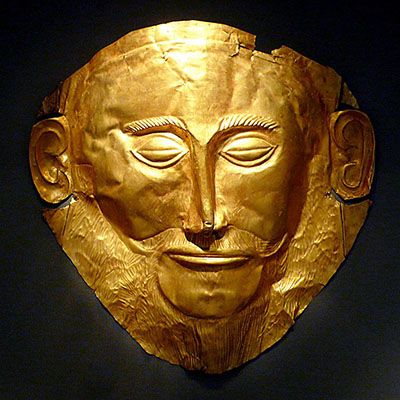
Funerary Mask
This gold mask features the facial impression of a man brought to life through the technique of repoussé, in which Mycenaean artists were highly skilled. Much care was taken by the artist to include clearly distinguishable facial features including individual hairs of the moustache and eyebrows.
This mask was one of several that were excavated from the shaft graves at Grave Circle A at the Mycenae citadel. Of all of the masks, however, this one is the most famous due as much to the controversy surrounding its proposed origins as its detail. Upon discovering this mask, archaeologist Henrich Schliemann declared it the funerary mask of the Mycenaean King Agamemnon. The find of a death mask of this legendary figure would have indeed been a great find, but today it is widely accepted that there is no evidential basis for this identification as a specific historical individual. According to author Fred Kleiner, this artwork, "...with its full beard, must depict a mature man, perhaps a king - although not Agamemnon, as Schliemann wished. If Agamemnon was a real king, he lived some 300 years after the death of the man buried in Grave Circle A."
Beaten gold - Collection of National Archaeological Museum, Athens, Greece
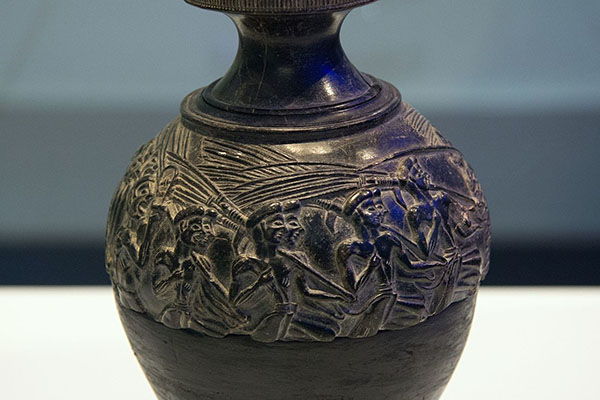
Harvesters Vase
Found in the architectural ruins of Hagia Triada on the island of Crete, the Harvesters Vase is a Minoan vase made of steatite, a soft stone, rather than clay. The bottom of the vase has not survived intact and was restored minimally for stability, but the top section features an elaborately detailed carved relief. In this scene several men appear to be marching as they carry farming tools most likely used in the harvested fields depicted behind them via long, incised lines. Mainly due to its egg shape, it has been identified as a rhyton, or ritual vessel with an original opening at the bottom as well as the top.
This work highlights a deliberate attempt by the Aegean artist to show a narrative. Whilst today we have no way of knowing exactly what his message was, its presence helps to distinguish this piece from the works of artists in other civilizations. According to author Fred Kleiner, "formulaic scenes of sowing and harvesting were staples of Egyptian funerary art, but the Minoan artist shunned static repetition in favor of a composition filled with individually characterized figures bursting with energy. The relief shows a riotous crowd singing and shouting as the harvesters go to or return from the fields. The artist vividly captured the forward movement and lusty exuberance of the youths."
One figure appears to be depicted holding a rattle, with mouth open as if in song. This is of particular interest and importance to the development of later artistic styles. As Kleiner explains, "...the artist depicted him in full profile with his lungs so inflated with air that his ribs show. This is one of the first instances in the history of art of a sculptor showing a keen interest in the underlying muscular and skeletal structure of the human body. The Minoan artist's painstaking study of human anatomy is a singular achievement, especially given the size of the Harvesters Vase, barely five inches at its greatest diameter. Equally noteworthy is how the sculptor recorded the tension and relaxation of facial muscles with astonishing exactitude, not only for this figure but for his nearest companions as well. This degree of animation of the human face is without precedent in ancient art."
Steatite, originally with gold leaf - Collection of Archaeological Museum, Iraklion, Crete
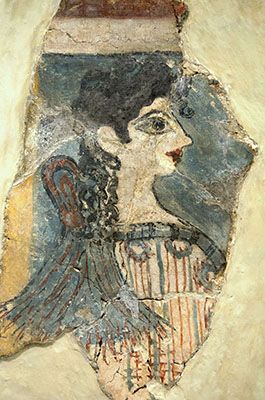
La Parisienne
La Parisienne is the title now used to describe a fragment of a wall fresco found in the palace at Knossos on the island of Crete. Measuring a mere ten inches high, this elaborately detailed female is shown in profile, although the large eye dominating her face, along with her bright red lips and long wavy black hair, appears frontal. This subtle composite perspective was common in Ancient Egyptian art. Even the detail of her dress is detailed with stripes of red and white and blue trimming. Her pale white skin conforms to the differentiation of female and male gender in much Aegean painting by skin color - white and brown, respectively.
Just who this woman depicts is a point of conjecture. According to author Fred Kleiner, "some have identified her as a priestess taking part in a religious ritual, but because the figure has no arms, it is more likely a statue of a goddess." Another author, Philip Betancourt, argues that the figure's "...elite role is signaled by an emblem called a 'sacred knot' behind her head and by the fact that she is seated and somewhat larger than the other human figures in the scene - the fragment is one of many small (mostly non-joining) pieces that came from a painting of seated figures being served drink and possibly food."
While this representation itself stands out as an important work of Aegean art, its elaborate detailing also may provide clues about Aegean dress during ceremonies and rituals, and also provides an excellent example of the pioneering, advanced buon or wet fresco technique of painting onto wet walls, allowing for better pigment preservation.
Pigment on wall - Collection of Archaeological Museum, Iraklion, Crete
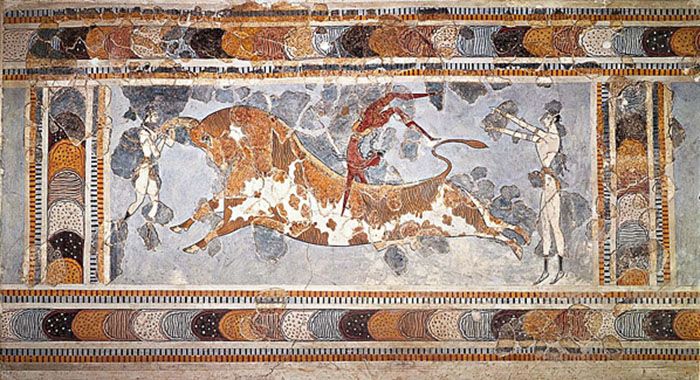
Bull-leaping
This fresco found on the walls of the palace at Knossos in Crete features the Aegean sport of bull-leaping. This activity had previously been dismissed as legendary, but it is now widely believed to have been a real athletic contest, similar to an event practiced in some parts of rural France known as the course landaise, in which men interact with bulls. At the center of the image is a charging bull, with one male figure in the act of vaulting over the beast, his arms straddling its back and his legs waving in the air. One female figure is holding the bull's horns, perhaps preparing to jump over the beast next while another female standing behind the bull has either finished leaping herself or is standing there waiting to assist the man as he completes his jump.
This fresco is an important example of Minoan art for several reasons. First, it highlights some of the key characteristics of Aegean art including curvilinear form (seen here on both the bull and the humans depicted), the long body type accentuated by extremely cinched and tiny waists, and gender differentiations in the skin color of males and females. Second, the imagery provides an explicit glimpse into an Aegean activity that we would have no other way of surmising, the popularity of which is also attested to in other Aegean works of art, although its specific performance context is not known. According to author Philip Betancourt, "Several writers who have discussed the subject have suggested that the acrobatics may have involved ritual practices, perhaps symbolizing human domination over the powers of nature. Possibly the bull was sacrificed for a religious feast after the conclusion of the ceremony." In addition, bull and composite human-bull images like the mythical minotaur beast associated with the labyrinth architectural plan at Knossos, are copious in Minoan art, attesting to the centrality of the animal in Minoan culture.
Fresco - Collection of Archaeological Museum, Iraklion, Crete
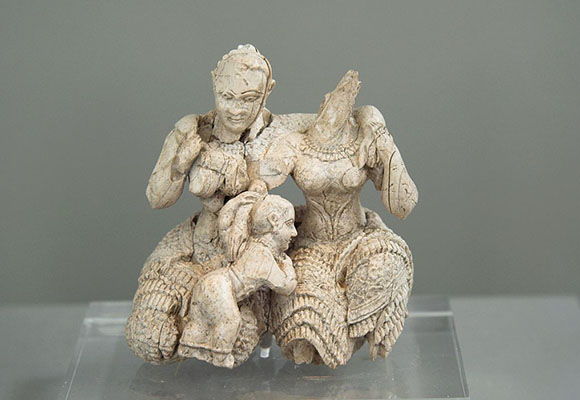
Ivory figurine representing three females
Measuring a mere two and three quarters inches high, this intricately carved sculpture features two ornately dressed women with their breasts exposed and arms around each other. While the head of only one of the figures remains today, her gaze is directed at what appears to be a small female child who leans against both the women's legs. According to Dr. Vassiliki Pliatsika on the National Archaeological Museum of Athens's website, the two adult females, "... wear the well-known Creto-Mycenaean garb with the tight short-sleeved bodice and the characteristic richly pleated skirt. They share an oblong estheta (shawl) that joins the two women on the back...."
The use of ivory, a rare and expensive material, shows not only the wealth of the Mycenaean people but also the potential importance of the figures depicted. As Dr. Pliatsika explains, "Alan Wace, the archaeologist who unearthed the ivory group [...] in 1939 believed that it depicted a sacred triad of goddesses. Even though the identities of the three figures cannot be established, it is obvious that the figurine illustrates an affectionate scene between the three females, who may represent three generations of the same family, since one of the adult women looks older than the other." If this is true then this sculpture also offers a rare depiction of a family unit in Aegean art. Its composition also intimates a potential prototype for later Greek sculptural goddess groupings.
Ivory - Collection of National Archaeological Museum, Athens, Greece
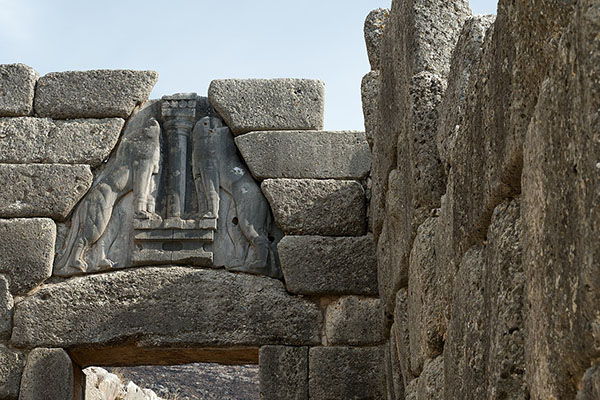
Lion Gate
The Lion Gate leads into the citadel at Mycenae, serving as a barrier to approaching enemies. As author Fred Kleiner explains, "it is protected on the left by a wall built on a natural rock outcropping and on the right by a projecting bastion of large blocks. Any approaching enemies would have had to enter this 20-foot-wide channel and face Mycenaean defenders above them on both sides. The gate itself consists of two great upright monoliths (posts) capped with a huge horizontal lintel. Above the lintel, the masonry courses form a corbeled arch." A mastery of Mycenaean engineering in its approximation of a true weight-bearing arch achieved much later by the Romans, this gate is equally important for the artwork it features, a relief of two large lions turned inward facing a large column which is placed between them. The lion heads are missing today, possibly indicating extreme high relief in their rendering and thus making them especially vulnerable to breakage. Importantly, according to authors Louise Hitchcock and Donald Preziosi, "the Lion Gate is unique for containing the only surviving example of a sculpted panel used to fill a relieving triangle."
The meaning carried by the emblematic feline design remains a mystery. As Hitchcock and Preziosi explain, "... we are confronted with at least two possibilities. Guardian animals placed at gateways have been traditionally regarded as apotropaic by many, signifying protection, strength, and stability. [...] Many other prominent scholars believe that the central column represents an aniconic deity. This interpretation fits within a long Bronze Age tradition attested in both the Aegean and the Near East of powerful animals flanking revered objects. If the animals were supernatural, this would certainly place the column in the realm of the supernatural." Whatever its original meaning, at the very least this artwork embodied, as author Philip Betancourt explains, "...a new symbol for the city over the rebuilt gate" offering a strong example of art being used to make a visual statement.
Limestone, relief panel - Mycenae, Greece
Beginnings of Aegean Art: Cycladic, Minoan, and Mycenaean
Defining the Time Period and Geography
The term 'Aegean Art' encompasses the artworks produced by the cultures that existed in the Aegean Sea during the Bronze Age (approximately 2800-1100 BCE). This rich culture of island communities and the southern mainland therefore predates Classical Greek and Roman Art. Life in the Aegean thrived in the second millennium BCE, although long after major civilization centers was established in Mesopotamia, Egypt, and South Asia - societies who traded with these island cultures. The variety of art coming from this region is generally attributed to three distinct yet related and often intermingling traditions - Cycladic, Minoan, and Mycenaean.
Cycladic art (works traced to the Cyclades islands) is the earliest, with most architectural finds dating from c. 3000 - c. 2000 BCE. This is followed by Minoan art, which is found largely on the island of Crete and dates mainly from c. 2000 - c. 1400 BCE. The last great period of Aegean civilization, c. 1400 to 1000 BCE, also encompasses settlements on the Greek mainland that are referred to as Mycenaean or, occasionally, Helladic. This art was influenced by the earlier Minoan work. Overlaps, intermingling, and historical and archeological debates about natural disasters that disrupted and shifted populations make categorical divisions between these three cultures approximate, with indistinct transitions from one dominant society to the next.
Currently, less is known about the lives of the ancient Aegeans than any other ancient peoples, such as the roughly contemporaneous Egyptians of the New and Middle Kingdoms. It is generally accepted that the Aegean civilization developed through this progression of the three major societies, with artistic remains revealing intermittent threads of continuity in imagery and techniques. Just how many people comprised each society is debated, but evidence demonstrates that some areas were quite populous throughout the era. The population at Knossos, one of several known ancient towns on Crete, has been variably estimated as between 15,000 and 50,000 people, for example.
The Discovery of Aegean Civilization
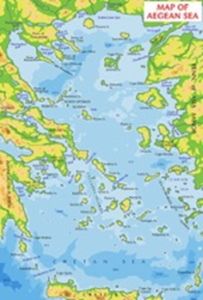
Historians first acknowledged a distinct Aegean civilization's existence after archeological excavations in the later 19th century yielded copious works of art, artifacts, and architectural ruins. These dated mainly from c. 3000 BCE to c. 1000 BCE and provided physical evidence of societies previously known primarily through legend and myth. According to authors Louise Hitchcock and Donald Preziosi, the discovery of ancient Knossos on Crete dates to 1878 when "...the Cretan antiquarian, Minos Kalokairinos, found the remains of large storage jars on the site of Kephala, several miles south of the modern port city of Herakleion. The find sparked an intense competition to identify and uncover the prehistoric city of Knossos". This was accomplished by British archeologist Sir Arthur Evans in 1900.
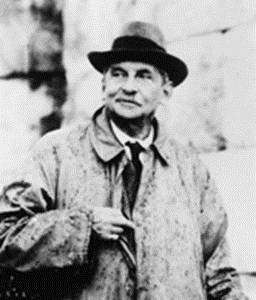
Evans understood the importance of his work on Crete, not only for the practice of archeology and subsequent work on ancient sites, but for the modern world, as research that would shape the mental attitude of [his] own and future generations in "many departments of knowledge." As author Philip Betancourt states, "the art of the Aegean Bronze Age is an important chapter in the early expression of ideas through visual metaphors. [...] The arts flourished, and the examples that survive into modern times present us with images in many media - monumental wall paintings, stone architecture at large scale, elite objects of gold, silver, and other metals, interesting sculptures, and thousands of fine small pieces in many styles." The tripartite division of Aegean civilization and its art has also facilitated the focused study of this breadth and abundance of artistic material.
German archaeologist Heinrich Schliemann also played a key role in proving that some of the mythical cities described in the epics of Homer were in fact real places. Schliemann's excavations at Mycenae on the mainland uncovered what author Fred Kleiner describes as startling finds, "among them a massive fortress-palace with an imposing gateway and a circle of royal graves; other tombs featuring lofty stone domes beneath earthen mounds; quantities of gold jewelry, drinking cups, and masks; and inlaid bronze weapons." These finds indicated a society far older than art of the Classical era suggested. Much of what is known of the Aegean civilization today dates back to these excavations, including how its art is discussed and documented.
Concepts and Styles
Cycladic Art: Early Statues
The earliest examples of Aegean Art come from among a group of 220 islands known as the Cyclades. The subgrouping "Cycladic art" relates to the art made by the inhabitants of these islands, who are understood to have been a nomadic people throughout the third millennium. According to author Philip Betancourt, "the portable art of the Early Cycladic period consists largely of small objects that could be carried easily if a community moved. The architecture is not very monumental, the tombs are small, and except for the substantial fortification walls, only modest amounts of labor were invested in objects intended for visual communication or for permanent display."
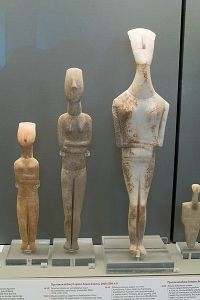
This Cycladic mode of artistic production is typified through simplified anthropomorphic stone statuary. While the purpose of these objects remains a mystery, more than a thousand have been found. Historians and archeologists suggest that it is likely that they had burial and votive functions.
The basic forms of these statues are rendered in clean and flat geometric shapes. Clearly, it was important to the artists to delineate gender, done so with breast protrusions and genital outlines on the figures, most of whom are female and depicted with straight legs and bent arms resting across their stomachs. The few extant male examples sometimes have more complicated poses and attributes like belts or musical instruments. Many have retained traces of pigment, suggesting that other details were originally added with paint.
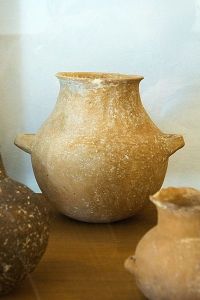
Whilst statuary is the most emblematic Cycladic art form, pottery was also produced by the nomadic population. According to Betancourt, this earliest pottery, "...was all handmade (rather than made on a potter's wheel). Bowls, jars, and other simple shapes served utilitarian functions, while a few more specialized shapes like the bottle were developed for specific purposes. [...] Oil, perhaps perfumed, is the most likely possibility for the contents, which were shipped to many places [...]." In addition to functional objects, some pieces of pottery were discovered in what are believed to be ancient tombs, suggesting a funerary function or ritual object for use by the deceased. One of the most interesting examples of this type of object is a flat piece that resembles a frying pan.
Minoan Art: Pottery, Architecture, and Wall Painting
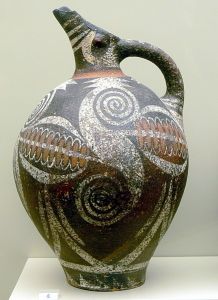
Pottery of the Minoan period was more advanced than that seen in Cycladic contexts, due in large part to the development and use of a potter's wheel and kiln firing techniques. Not only were these Minoan vessels more elaborately formed with greater variety in shape, but also more highly decorated with polychrome schemes. An early Minoan type known as Kamares ware, "named for the cave on the slope of Mount Ida where they were first discovered," according to Fred Kleiner, "have been found in quantity at Phaistos and Knossos. Some examples come from as far away as Egypt and testify to the expansive trade network of the Minoans."
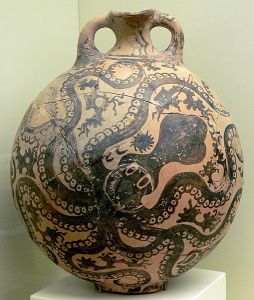
Decoration on Minoan pottery was rich and varied. Kamares ware generally featured highly abstract patterns, with strong color contrasts between light and dark. Surrounded as they were by water on the island of Crete and the nearby smaller outposts they established as their culture expanded, the Minoans were deeply inspired by aquatic life. Designs featuring sea creatures, frequently the octopus and the dolphin, gave rise to an alternative description of this work as "Marine Style". A later decorative motif is known as the "Palace Style", in which, according to authors Debby Sneed and Summer Trentin, "... the earlier decorative motifs of plants, flowers, and sea life are arranged symmetrically and in a greatly stylized manner." All of these decorative types were popular in Minoan trade, judging from the dispersed archeological finds across the islands of the Aegean and beyond.
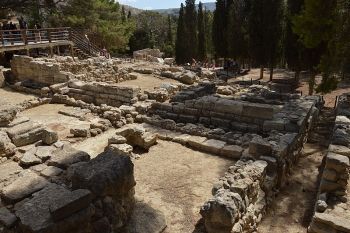
From an architectural perspective, the grandest period of Aegean civilization arguably took place on Crete during the Minoan period. Rather than the remains of simple homes found on the Cyclades from this period, excavators on Crete uncovered large architectural complexes. It is generally believed a large fire destroyed similar earlier structures in 1700 BCE, after which an extensive building campaign was launched by the Minoans, resulting in newly elaborate structures. The remains of these structures survive to today, and can be seen at their excavation sites, many of which have become popular tourist destinations. According to author Fred Kleiner, "Although conventionally called palaces, the rebuilt structures may not have served as royal residences. They were administrative, commercial, and religious centers with courtyards for pageants, ceremonies and games, and dozens of offices, shrines, and storerooms for the collection and distribution of produce and goods. These huge complexes were the centers of Minoan life. The principal 'palaces' on Crete are at Knossos, Phaistos, Malia, Kato Zakro, and Khania."
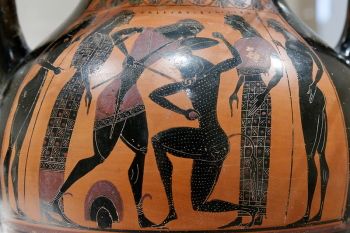
The elaborate layouts of Minoan palaces evidence advanced engineering skills and detailed aesthetic ambitions. At Knossos, widely considered to be the home of King Minos (a major figure in Homer's tales), the intricate and maze-like floor plan suggests the labyrinth of the man-eating Minotaur beast, whom the hero Theseus kills to win the hand of the king's daughter in Greek mythology.
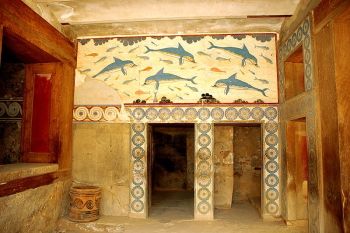
More than simply proof of masterful architectural skills, these palace complexes indicate the refined aesthetics sensibilities of the Minoans, as they are filled with beautifully rendered frescoes and mural paintings. According to Kleiner, "the paintings depict many aspects of Minoan life (bull-leaping [generally believed to have been a popular Aegean sport], processions, and ceremonies) and of nature (birds, animals, flowers, and marine life)." The rich detail displayed in these murals as well as the focus on movement and naturalism specifically found in Minoan landscape scenes marked a sharp contrast to the more rigid, formally rendered art of the Ancient Egyptians. Egyptian art did make it to the Aegean to some degree however, as its influence has been identified in some floral patterning and color conventions. But unlike the Egyptians, who used a dry fresco technique of painting directly onto the walls of their tombs, the Minoans invented a new technique known as wet fresco or "buon fresco", in which the artists painted onto a wall that had been first treated with a wet lime plaster. The results were better preserved as the pigment dried within the plaster. This technique has allowed for the remains of Aegean wall paintings to still be seen today.
Mycenaean Art: Architecture, Metal Work, and Terracotta Figures
The Mycenaeans, the third culture usually grouped under the term “Aegean Art”, flourished during the middle to late years of the Aegean Bronze Age, were indigenous Greeks inhabiting mainland Greece centuries before the Classical Greek civilization (as we understand it today) emerged. The Mycenaeans, an advanced people with their own culture and extensive trade practice, also showed some influence from the Minoans. Whilst for years direct ancestral links between the cultures of the Aegean had been assumed but not conclusively demonstrated, recent genetic, linguistic, and archeological work has confirmed that the Minoans and Mycenaeans are closely related to both ancient and contemporary Greeks.
Mycenaeans are best remembered today for the treasures found buried amongst the remains at Mycenae, the most extensive of several known Mycenaean citadels or town centers.
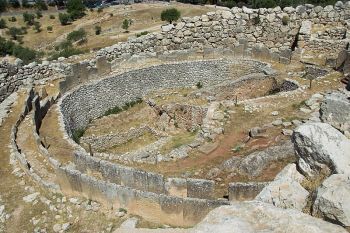
Mycenaean architecture is sometimes referred to as Cyclopean, after the giant Cyclops of Greek mythology, for its massive stone construction. One monumental form is the beehive-shaped tomb, which was constructed largely of ashlar masonry (cut stone) and sometimes covered in earth to appear as a natural mound. Notable is its dome-like interior ceiling span. This was achieved through the technique of corbeling, or raising a series of gradually sloping fitted stone courses, a technique which predates the arch technology that would define later styles of European architecture.
The largest of these tombs, found outside the Mycenae citadel, is widely known as the Treasury of Atreus, a legendary Mycenaean king. While this tomb was looted before a record of what was inside could be documented, excavations led by Henrich Schliemann uncovered large underground shafts now known as "Grave Circles" inside the citadel that yielded spectacular finds. Believed to be burial places for Mycenaean kings and their relatives, the graves contained a wealth of artworks buried with the bodies which provided historians with insights into the makeup and culture of the society they came from. As authors Louise Hitchcock and Donald Preziosi have noted, "the scale of the wealth displayed in the shaft graves at Mycenae, and the power of the warrior classes for whom such objects were made, had no immediate precursors in Greece, and the growth of regional centres such as Mycenae heralds an entirely new age in the Aegean."
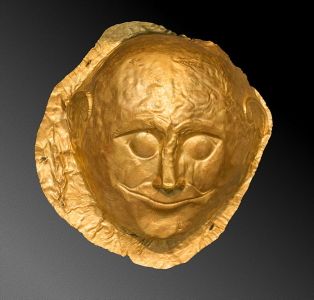
Among the treasures found in the shaft graves were funerary masks, which were the cause of some debate when Schliemann attributed one to Agamemnon, the legendary son and successor of Atreus. This is a theory which has since been disproved. As author Fred Kleiner explains, "no one knows whether the Mycenaean masks were intended as portraits, but the artists took care to record different physical types. The masks found in Grave Circle A portray youthful faces as well as mature ones."
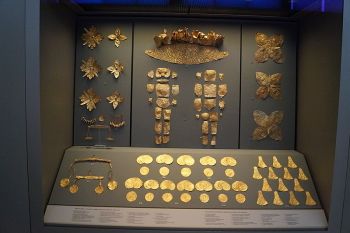
Other items found in these shaft graves include highly decorative gold and metal cups, jewelry, and weaponry, all of which highlight the Mycenaeans' skill in metallurgy. This included a mastery of repoussé, the hammering of forms from the back side of a metal sheet to create a sculptural relief, with details later refined from the front using other techniques. According to author Philp Betancourt, "the sophisticated Mycenaean economic and political system led to increasing affluence among the elite members of the society," an affluence to which these burial objects attest.
While the increasing wealth and power of the Mycenaean people allowed for larger sculptures to be made than in earlier Aegean societies, the most abundant works of art found in their graves and tombs were small figurative sculptures.
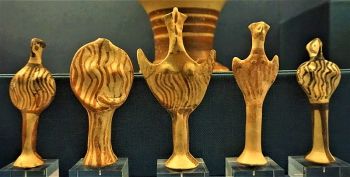
Mycenaean grave statuettes, while harking back to the simplified carved Cycladic figures of the Early Bronze Age, are generally terracotta, clay fired in kilns, and less geometric. They also frequently display better preserved painted details. Many share the gesture of upraised arms that was first seen in the "goddess" statues of the Minoan period. There are so many of these Mycenaean figures that, as author J. Porter explains, "they are categorized into three main types, based on the gestures of their arms and were named by their resemblance to the letters of the Greek alphabet: tau, phi, and psi. The tau figurines fold their arms into their chest, the phi figurines clasp their hands in their stomach, and the psi figurines raise their hands."
As with most Aegean artworks, the purpose for the production of these Mycenaean sculptures can only be hypothesized. According to Porter, researchers have suggested that they may be representations of goddesses for votive function, or toy-like objects for children, as many have been found in children's tombs. They may have had uses in both life and death, in light of the varied find spots and evidence that some were purposely broken and discarded.
Later Developments and Legacy
There is no clear historical record that accounts for the end of Aegean civilization, nor what historical links may exist between this end and the start of a later recognizably Greek civilization. Some proposed theories include one or several environmental disasters such as volcanic eruption or invading groups that decimated the population. In fact, art of the region has offered some clues to support the theory that the Aegeans faced several threats around the late second millennium BCE.
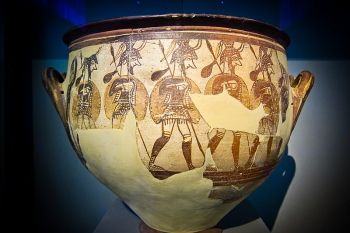
As authors Louise Hitchcock and Donald Preziosi have proposed, extensive trade that flaunted the wealth of the Mycenaeans "may have invited piracy by renegade warriors [...] as recounted in the annals of the Hittites. Or, as the Mycenean cities fell to mercenary insiders and bands of rustic marauders from both northern Greece and central Europe, their inhabitants might, in turn, have been encouraged to flee their homes." Certainly, imposing architectural structures such as the Lion Gate and connected large walls surrounding the citadel at Mycenae were designed to make invasion difficult, suggesting the threat of attacks, especially when viewed alongside the warrior imagery on some late Mycenaean pottery.
Legacy of Aegean Art
Ancient Aegean art had a profound impact on the subsequent development of artistic imagery and techniques, an influence that can be seen even in contemporary times. Regarding its primary impact on the art of Classical Greece and Rome, according to author Philip Betancourt, "... without its long centuries of experimentation and innovation, those traditions would surely have traveled other paths."
Curiously, not all elements of Aegean art were copied by later artists. As Betancourt states, "...some of the Aegean Bronze Age art is surprisingly different - even shockingly different - from what came later. The rich culture we call Minoan [...] presents us with experiences that are foreign to Classical Greek and Roman ideas [...] and some of the Minoan images use concepts that are also quite alien to the ones that guided many other traditions of this part of the world." This uniqueness underpins the importance of Aegean Art as a period, both in its own right and as a precursor to other better-known and documented periods. As Betancourt continues, it first "stands at the beginning of a long later history that can neither be understood nor appreciated without at least a passing acquaintance with its first chapter. Second, Cycladic, Minoan, and Mycenaean visual communication is important for its own sake. It presents some ideas in ways that have not been explored in the same fashion anywhere else, either before or since."

One of the most prominent legacies of the Aegeans is the development of new artmaking techniques, techniques that often emerged from day-to-day life within the island cultures. Their advancements include the use of a potter's wheel and kiln that would later become fundamental to the expansive enterprise of Ancient Greek pottery. Also, the buon fresco technique was adopted and used to great effect by future generations of artists, especially notable in Italian Renaissance art, epitomized by Michelangelo's work on the ceiling of the Sistine Chapel (1508-12). It remained in use to the modern era, reaching another high point in post-revolutionary Mexico, when Diego Rivera and others refurbished public buildings with extensive mural projects.
The influence of the Aegeans on Classical Greek architecture was also significant. The grand scale and copious decoration at Minoan and Mycenaean sites was echoed and furthered in Greek temple construction in particular. In addition, the Aegean interest in the human figure, which, while simplistically rendered, can be seen from early Cycladic art through the end of Aegean civilization, laid the foundation for the focus on figuration in Greek art. Likewise the original polychrome of at least some Aegean sculpture and some nature-based design elements of Minoan wall and pottery painting can be seen in some of the decorative friezes featured on Greek temples.
Beyond the direct influence that Aegean art had on Classical Greek culture, which eventually re-settled the Aegean islands, and by extension the Romans who were heavily influenced by the Greeks, Cycladic art, specifically, has impacted many modern artists. As author Julia Fiore states, "...the avant-garde retinue - Hans Arp, Constantin Brâncuși, Amedeo Modigliani, Henry Moore, Alexander Archipenko, Pablo Picasso, Jacob Epstein, Henri Gaudier-Brzeska, Alberto Giacometti, Jacques Lipchitz, and Isamu Noguchi, among others" partook in a "... craze for these elegant, prehistoric artifacts around the turn of the century" as part of a catch-all, emerging notion of Primitivism that included non-European as well as other early European art to mark an emphatic break from enduring realist art traditions spawned from Classical Greece. This can be seen perhaps most prominently in the angular, flatly rendered heads and elongated faces of Amedeo Modigliani's subjects in painting and sculpture. Further, according to Fiore, "the presumed fertility function of many Cycladic artifacts [...] inhabits the sensual sculptures of Hans Arp or Alexander Archipenko, albeit in a secular, rather than religious sense." Even Pablo Picasso, while heavily influenced by African art, echoes Cycladic form in his early Cubist geometry as well as work of his later "classical period." And the Minoan bull iconography is echoed in many of Picasso's works that featured the mythic minotaur.
Useful Resources on Aegean Art: Cycladic, Minoan, and Mycenaean
- Aegean Art and ArchitectureOur PickBy Donald Preziosi and Louise A. Hitchcock
- Gardner's Art through the Ages: The Western PerspectiveOur PickBy Fred S. Kleiner
- Introduction to Aegean ArtOur PickBy Philip P. Betancourt
- The Cambridge Companion to the Aegean Bronze AgeBy Cynthia W. Shelmerdine
- The Oxford Handbook of the Bronze Age AegeanBy Eric H. Cline
 Ask The Art Story AI
Ask The Art Story AI